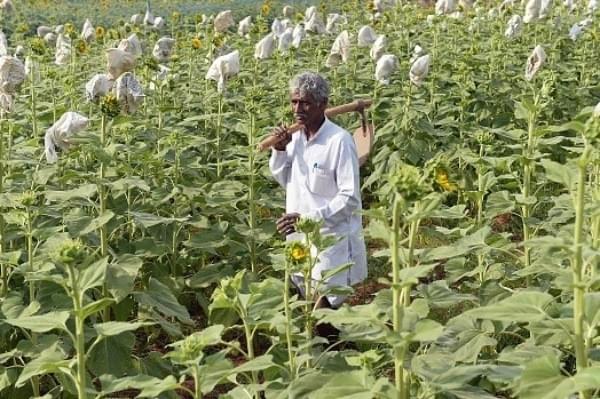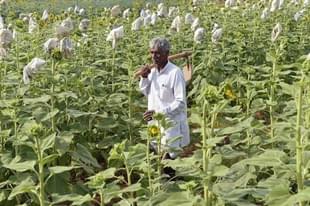Politics
Is Loan Waiver The Only Way? How About Financing Farmers?
Rhea Reddy
Aug 02, 2019, 02:23 PM | Updated 02:23 PM IST
Save & read from anywhere!
Bookmark stories for easy access on any device or the Swarajya app.


It is often said that farmers are the backbone of any nation. However, in Maharashtra alone, over 12,000 farmers have committed suicide in the past three years. The root cause of this is the agrarian distress in the state. This distress is exacerbated by the burden of debt, increasing prices of input, and anti-agriculture policies, among others.
In attempting to mitigate the agrarian crisis, state governments across India undertook various schemes ranging from farm loan waivers to financial aid and subsidies.
After the All Kisan Sabha farmer protest across Maharashtra in 2017, the state government agreed to a partial loan waiver amounting to thirty thousand crore rupees. This loan waiver would erase out-standing credit, allowing debt-ridden farmers to be able to borrow anew for the next crop cycle.
However, as input costs rise and output prices fall, farm incomes are becoming unviable. Therefore, the farmers are only given a temporary relief through these loan waivers. Farm loan waivers further disadvantage the farmers that pay their loans promptly, which creates a culture of attempting to withhold payments until loans are waived.
In 2018, the Telangana government went a step further and implemented the ‘Rythu Bandhu’ scheme that provides financial aid to landed cultivators. The scheme provided for grants of four thousand rupees per acre per farmer for the purchase of inputs such as seeds and fertilisers. In 2019, this was enhanced to five thousand rupees per acre per farmer.
However, since the scheme benefitted only those with land titles reflected in government records, tenant-farmers, woman-farmers without titles, and others were excluded. Uniform investment support for both rich and poor farmers alike further ingrained their economic inequalities. The farmers, therefore, found this scheme inequitable.
The most recent attempt to counter agrarian distress is the “Krushak Assistance for Livelihood and Income Augmentation” (KALIA) Scheme. It was implemented in Orissa by Naveen Patnaik, the state’s Chief Minister. It would aim to provide financial aid of Rs. 25,000 per farm family to small and marginal farmers. Rs. 12,500 would further be provided to each landless agricultural household engaged in agricultural allied activities such as goat rearing or bee-keeping.
Naveen Patnaik announced that the scheme would “accelerate agricultural prosperity in the state and reduce poverty.” It would also be more effective in aiding the “real cultivators”, like landless labourers. But solely financial aid is not enough to reduce poverty in the long run.
Assistance for Cultivation
Over five seasons, Rs. 25,000 per farm family would be provided to marginal farmers holding below 2.5 acres of land and small farmers with 2.5-5 acres of land, for the purchase of seeds, fertilisers, and other investments. Although this would help in reducing the financial burden on farmers, its effects would not be felt evenly.
As the scheme provides the same financial aid irrespective of the amount of land owned, small farmers would not fare as well as marginal farmers. Small farmers would need to buy seeds, fertilisers, and other necessities in greater quantity, hire more labourers, as well as invest more heavily in tractors and machinery to be able to compete with rich farmers. Without aid proportionate to their investment, they would find it harder to break away from their cycle of debt.
Roughly 90 per cent of farmers will also be provided with Rs. 5000 for Kharif and Rs. 5000 for Rabi crops over five crop seasons. Due to this, farmers may shift from growing regional varieties throughout the year to profitable Kharif and Rabi crops. This homogeneous cropping pattern would lead to the loss of regional varieties of crops or local staples.
Furthermore, the lack of genetic diversity would make crops more prone to being destroyed by changing environmental conditions and diseases. The prices for produce would also fall due to market saturation,and monoculture would increase the need for fertilisers to replace nutrients in the soil.
To prevent this, farmers would then have to invest more heavily in pesticides and other risk mitigating options. Therefore, farmers would face additional financial burdens.
Assistance for Vulnerable Cultivators/ Labourers
Aid is also given per farm family, which constitutes a farmer and his/her spouse, along with their dependent children. In a largely family-oriented society like India, there may be a higher number of dependent members unable to work, including the elderly, sick, and the differently-abled.
To offset this, the scheme provides for Rs. 10,000 per family per year to be given to these vulnerable persons for their sustenance. But without considering the number of dependents and vulnerable persons within the family and the nature of their disability, this aid would bring little relief.
The specific needs of differently-abled persons and the various necessary treatments for the sick create a greater financial strain on some families. The expenses for these treatments also depend on variation in social climate, like public healthcare [Amartya Sen, Development as Freedom 88 (Anchor Books, 1999)].
Thus, additional costs may include travelling into cities for frequent check-ups and proper health care, prosthesis, advanced treatments, and so on. To alleviate this burden, it may be more beneficial for the government to invest in free or subsidised rural healthcare services, as monetary relief alone may not be enough to cover the various aforementioned costs.
Risk Management
The Accidental Death and Suicides in India report (2015) attributes the major causes of farmer/cultivator suicides to be poverty, bankruptcy, and indebtedness [All India level Causes-wise Distribution of Farmers/Cultivator Suicides during 2015, Accidental Deaths & Suicides in India-2015, Ministry of Home Affairs ].
To eradicate or reduce poverty, the World Development Report 2014 (World Bank, 2014) has emphasized on the management of risks. Therefore, the government ought to invest in satisfactory measures in order to tackle not only environmental risks, like floods or droughts, but also socio-economic and political ones.
The scheme further does not consider losses due to climatic conditions like insufficient rains. Such conditions lead to crop failure and distress sales. The expenses for child education, accidents and injuries, and irregularities of rainfall all add to the mounting financial burden on farmers. Therefore, solutions must be aimed towards mitigation of risks.
Insufficient rains and droughts also aggravate the problems caused by water markets, leading to excessive exploitation of groundwater and inequitable distribution of gains. According to the Indian Agricultural Research Institute (IARI), this mainly affects small and marginal farmers with fragmented farm size that are not able to access groundwater [D R Singh and Prawin Arya, Water Markets and its implications to small farmers, Indian Agricultural Research Institute, 2016 ].
Effective policy and regulations on these issues would ensure that poor farmers aren’t forced to invest excessive amounts of money for meagre, if any, profits.
Conclusion
Though the KALIA scheme does provide incentives for pursuing agriculture-allied activities and reduces the burden on vulnerable persons, it does not invest in helping farmers become self-sufficient in the long run. It also does not ensure that the financial aid being given is used for agricultural purposes. Therefore, an ends-based approach rather than a means-based approach needs to be adopted.
In addition, since the state of Odisha has fewer financial and administrative resources, the Rs. 10,180 crores earmarked for the scheme could be put to more effective use by investing in technology, educating farmers in the best agricultural practices, risk mitigation, and research into effective policy.
The government must attempt to look at the deprivation of basic capabilities or substantive freedoms preventing farmers from living a life they have reason to value, rather than adopt an income-based approach for the purpose of convenience. Barriers like the lack of education, technology, and public healthcare should be the focus of poverty-reducing government schemes instead.
By addressing the lack of income without its social and economic context, farmers cannot be lifted out of their poverty.





